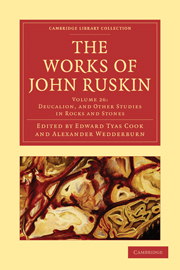Book contents
- Frontmatter
- Contents
- LIST OF ILLUSTRATIONS
- INTRODUCTION TO THIS VOLUME
- I ON THE FORMS OF THE STRATIFIED ALPS OF SAVOY (1863)
- II NOTES ON THE SHAPE AND STRUCTURE OF SOME PARTS OF THE ALPS, WITH REFERENCE TO DENUDATION (1865)
- III ON BANDED AND BRECCIATED CONCRETIONS (1867–1870)
- IV DEUCALION: COLLECTED STUDIES OF THE LAPSE OF WAVES AND LIFE OF STONES (1875–1883)
- V ON THE DISTINCTIONS OF FORM IN SILICA (1884)
- VI CATALOGUES OF MINERALS
- 1 CATALOGUE OF A SERIES OF SPECIMENS IN THE BRITISH MUSEUM (NATURAL HISTORY) ILLUSTRATIVE OF THE MORE COMMON FORMS OF NATIVE SILICA (1884)
- 2 CATALOGUE OF MINERALS IN ST. GEORGE'S MUSEUM, SHEFFIELD (1877–1886)
- 3 CATALOGUE OF FAMILIAR MINERALS IN THE MUSEUM OF KIRKCUDBRIGHT (1884)
- 4 CATALOGUE OF THE COLLECTION OF SILICEOUS MINERALS GIVEN TO AND ARRANGED FOR ST. DAVID'S SCHOOL, REIGATE, BY JOHN RUSKIN (1883)
- 5 CATALOGUE OF MINERALS PRESENTED TO THE CONISTON INSTITUTE (1884)
- 6 CATALOGUE OF MINERALS SHOWN AT EDINBURGH (1884)
- 7 NOTES ON MINOR COLLECTIONS
- VII THE GRAMMAR OF SILICA (not hitherto published)
- APPENDIX: LETTERS, ADDRESSES, AND NOTES
- INDEX
- Plate section
6 - CATALOGUE OF MINERALS SHOWN AT EDINBURGH (1884)
Published online by Cambridge University Press: 05 March 2012
- Frontmatter
- Contents
- LIST OF ILLUSTRATIONS
- INTRODUCTION TO THIS VOLUME
- I ON THE FORMS OF THE STRATIFIED ALPS OF SAVOY (1863)
- II NOTES ON THE SHAPE AND STRUCTURE OF SOME PARTS OF THE ALPS, WITH REFERENCE TO DENUDATION (1865)
- III ON BANDED AND BRECCIATED CONCRETIONS (1867–1870)
- IV DEUCALION: COLLECTED STUDIES OF THE LAPSE OF WAVES AND LIFE OF STONES (1875–1883)
- V ON THE DISTINCTIONS OF FORM IN SILICA (1884)
- VI CATALOGUES OF MINERALS
- 1 CATALOGUE OF A SERIES OF SPECIMENS IN THE BRITISH MUSEUM (NATURAL HISTORY) ILLUSTRATIVE OF THE MORE COMMON FORMS OF NATIVE SILICA (1884)
- 2 CATALOGUE OF MINERALS IN ST. GEORGE'S MUSEUM, SHEFFIELD (1877–1886)
- 3 CATALOGUE OF FAMILIAR MINERALS IN THE MUSEUM OF KIRKCUDBRIGHT (1884)
- 4 CATALOGUE OF THE COLLECTION OF SILICEOUS MINERALS GIVEN TO AND ARRANGED FOR ST. DAVID'S SCHOOL, REIGATE, BY JOHN RUSKIN (1883)
- 5 CATALOGUE OF MINERALS PRESENTED TO THE CONISTON INSTITUTE (1884)
- 6 CATALOGUE OF MINERALS SHOWN AT EDINBURGH (1884)
- 7 NOTES ON MINOR COLLECTIONS
- VII THE GRAMMAR OF SILICA (not hitherto published)
- APPENDIX: LETTERS, ADDRESSES, AND NOTES
- INDEX
- Plate section
Summary
GROUP I.—1–20
Introductory Examples, ascending from COMMON FLINT to PERFECT ENDOGEN AGATE
Amber chalcedony with flint.
Quartzite chalcedony with cycloidal superstructure.
Cycloidal chalcedony in films on flint.
Flint with chalcedonic fissure.
Nodule of red flint-chalcedony.
Chalcedony in stalactitic coats, varying in their lines of current.
Finest state of pure chalcedony, in irregularly combined rods and films.
Chalcedony on hæmatite.
Spheroidal haematite in quartz.
Grey spheroidal agate, partly stalactitic.
Perfectly formed agatescent stalactite, of white chalcedony, with external quartz.
Agatescent stalactites of pure chalcedony, with green, more or less tubular, centres.
Filiform chalcedony with green tubular centres, its threads collecting gradually into a solid mass.
Filiform chalcedony, with green centres, not tubular.
Pisolitic heliotrope (showing the spherical structure at the edge).
Pisolitic heliotrope in parallel bands. Look at it by transmitted light.
Tubular agate, the common form, but a singularly fine example.
Pure spheroidal agate, developing itself round an earthy stalactitic centre, with external quartz (magnificent).
Half of a perfect geode of spheroidal agate, with external quartz.
Portion of a nodule of irregularly muscose and spheroidal agate, with external quartz.
Note especially in this example, on its polished side, the portion of the external salmon-coloured band of the agate, which has been separated from the rest and carried up into the body of the crystallizing quartz.
- Type
- Chapter
- Information
- The Works of John Ruskin , pp. 519 - 526Publisher: Cambridge University PressPrint publication year: 2010First published in: 1906



